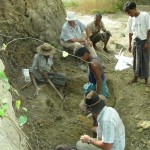
The carnivorous ceratosaurs were one to two metres in height. Image: Brian Choo
An anklebone fossil has revealed that the ceratosaurs called Australia home.
Ceratosaurs are a carnivorous group of dinosaurs that evolved during the Jurassic period and have been found on every continent except Antarctica. This discovery is the first evidence of ceratosaurs in Australia, confirming that they had a global distribution.
“They really were a cosmopolitan group of dinosaurs in terms of their distribution,” says Museum Victoria palaeontologist Dr Erich Fitzgerald, author of the study published in Naturwissenschaften.
The six-centimetre fossil was found in 2006 near San Remo, 87 kilometres southeast of Melbourne, by Mike Clearland, a long-term active member of a field exploration program run by the museum. He has already discovered a number of fossils, according to Fitzgerald.
“He scours the rocks with his eyes and walks the coast when he can, looking for fossils. And he has an exceptionally high aptitude for finding the fossils.”
Despite only finding one bone so far, the researchers have been able to identify it as belonging to a ceratosaur. “In the case of carnivorous dinosaurs, if you were only to find one bone, the ankle bone is the one you really want to find,” Fitzgerald says.
The distinctive features of carnivorous dinosaurs’ anklebones allow the researchers to determine which species a specimen would have belonged to. While they can’t confirm that this particular fossil belonged to a new species, it appears to be distinctive from the anklebones of all previously identified ceratosaurs.
The discovery not only adds to the growing inventory of Australian carnivorous dinosaurs, but also contributes to our understanding of how they evolved. It has been previously suggested that Australian dinosaurs, like marsupials and other mammals, reflected the isolation of the Australian continent.
However, the carnivorous dinosaurs that lived here — tyrannosaurs, spinosaurids, allosaurs and now ceratosaurs — evolved 170 million years ago during the Jurassic period. There were still substantial land connections and the dinosaurs would have been able to travel between any two continents.
This suggests that Australia’s dinosaurs may represent the groups that achieved a global distribution before the continents separated. “It’s the old age of their lineages — not continental isolation — which explains these dinosaurs’ presence in Australia.”
Australia is one of the last frontiers for dinosaur discovery, as it has the most poorly known record apart from Antarctica. However, discovery rates are accelerating and Fitzgerald suggests that we may be on the verge of a renaissance of dinosaur discovery, similar to those experienced in Europe and North America a century ago.
“Each discovery has the potential to change what we know,” he says.






